Geotourism and Local Development in Rural Areas: Geomorphosites as Geotouristic Resources in Sierras de la Paramera y Serrota, Spain
Abstract
1. Introduction: Geoheritage, Geotourism, and Local Development in Natural Protected Areas
2. Methodology
3. Study Zone: Sierras de la Paramera y Serrota
4. Results
4.1. Geomorphosite Inventory
4.2. Geomorphosite Use Potential and Geotourism Assessment
5. Discussion
6. Conclusions
Author Contributions
Funding
Data Availability Statement
Conflicts of Interest
Abbreviations
| NPAs | Natural Protected Areas |
References
- Reynard, E.; Coratza, P. Scientific research on geomorphosites. A review of the activities of the IAG working group on geomorphosites over the last twelve years. Geogr. Fis. Din. Quaternaria 2013, 36, 159–168. [Google Scholar] [CrossRef]
- Panizza, M. Geomorphosites: Concepts, methods and example of geomorphological survey. Chin. Sci. Bull. 2001, 46, 4–6. [Google Scholar] [CrossRef]
- Reynard, E.; Panizza, M. Geomorphosites: Definition, assessment and mapping. Géomorphosites 2005, 11, 177–180. [Google Scholar] [CrossRef]
- Reynard, E. Geomorphosites: Definitions and characteristics. In Geomorphosites; Reynard, E., Coratza, P., Regolini-Bissig, G., Eds.; Verlag Dr. Friedrich Pfeil: Munich, Germany, 2009; pp. 9–20. [Google Scholar]
- Newsome, D.; Dowling, R. Geoheritage and Geotourism. In Geoheritage; Elsevier: Amsterdam, The Netherlands, 2018. [Google Scholar] [CrossRef]
- Coratza, P.; Reynard, E.; Zwoliński, Z. Geodiversity and Geoheritage: Crossing Disciplines and Approaches. Geoheritage 2018, 10, 525–526. [Google Scholar] [CrossRef]
- Serrano, E.; González Amuchastegui, M.J.; Ruiz Pedrosa, R.M. Patrimonio natural y geomorfología. In Los Lugares de Interés Geomorfológico del Parque Natural del Cañón del Río Lobos; Ediciones Universidad de Valladolid: Valladolid, Spain, 2020. [Google Scholar]
- Kubalíková, L. Geomorphosite assessment for geotourism purposes. Czech J. Tour. 2014, 2, 80–104. [Google Scholar]
- Gordon, J.E. Rediscovering a Sense of Wonder: Geoheritage, Geotourism and Cultural Landscape Experiences. Geoheritage 2012, 4, 65–77. [Google Scholar] [CrossRef]
- Newsome, D. Geotourism; Routledge: London, UK, 2006. [Google Scholar]
- Ólafsdóttir, R.; Dowling, R. Geotourism and Geoparks-A Tool for Geoconservation and Rural Development in Vulnerable Environments: A Case Study from Iceland. Geoheritage 2014, 6, 71–87. [Google Scholar] [CrossRef]
- Dóniz-Páez, F.J.; Becerra-Ramírez, R.; García-Romero, L.; Hernández Ramos, W. Itinerario geoturístico en el Valle de El Golfo como ejemplo de desarrollo territorial en el Geoparque Mundial Unesco de El Hierro, España. XXV Coloq. Hist. Canar.-Americana 2022, 25, XXV-048. [Google Scholar]
- Kubalíková, L. Assessing geotourism resources on a local level: A case study from Southern Moravia (Czech Republic). Resources 2019, 8, 150. [Google Scholar] [CrossRef]
- Coratza, P.; Hobléa, F. The Specificities of Geomorphological Heritage. In Geoheritage; Reynard, E., Brilha, J., Eds.; Elsevier: Amsterdam, The Netherlands, 2018; Volume 5, pp. 87–106. [Google Scholar] [CrossRef]
- Kubalíková, L.; Drápela, E.; Bajer, A.; Zapletalová, D.; Balková, M.; Zágoršek, K.; Kirchner, K.; Kuda, F.; Roštínský, P. Geological paths—Their use for the regional geography teaching. In Proceedings of the 27th Central European Conference, Brno, Czech Republic, 17 October 2019; pp. 113–124. [Google Scholar] [CrossRef]
- Tormey, D. New approaches to communication and education through geoheritage. Int. J. Geoheritage Parks 2019, 7, 192–198. [Google Scholar] [CrossRef]
- Gray, M. Geodiversity: The backbone of geoheritage and geoconservation. In Geoheritage; Reynard, E., Brilha, J., Eds.; Elsevier: Amsterdam, The Netherlands, 2018; pp. 13–25. [Google Scholar] [CrossRef]
- Stojilković, B.; Gray, M. Geodiversification: The Evolution of Geodiversity Through Time. Geoheritage 2024, 16, 91. [Google Scholar] [CrossRef]
- Torabi Farsani, N.; Coelho, C.; Costa, C. Geotourism and Geoparks as Gateways to Socio-cultural Sustainability in Qeshm Rural Areas, Iran. Asia Pac. J. Tour. Res. 2012, 17, 30–48. [Google Scholar] [CrossRef]
- Ruiz-Pedrosa, R.M.; González-Amuchástegui, M.J.; Serrano, E. Geomorphosites as Geotouristic Resources: Assessment of Geomorphological Heritage for Local Development in the Río Lobos Natural Park. Land 2024, 13, 128. [Google Scholar] [CrossRef]
- Pralong, J.-P. A method for assessing tourist potential and use of geomorphological sites. Géomorphologie Relief Process. Environ. 2005, 11, 189–196. [Google Scholar] [CrossRef]
- Brilha, J. Inventory and Quantitative Assessment of Geosites and Geodiversity Sites: A Review. Geoheritage 2016, 8, 119–134. [Google Scholar] [CrossRef]
- Serrano, E.; González-Amuchastegui, M.J.; Ruiz-Pedrosa, R.M. Geomorphosites and geomorphological maps applied to public use, tourism and natural heritage management in the Rio Lobos Natural Park (Spain). Geomorphology 2025, 471, 109573. [Google Scholar] [CrossRef]
- Capote, R.; Diaz, M.; Gabaldon, V.; Gomez, J.J.; Sanchez de la Torre, L.; Ruiz, P.; Rosell, J.; Sopeña, A.; Yebenes, A. Evolución Sedimentológica y Tectónica del Ciclo Alpino en el Tercio Noroccidental de la Rama Castellana de la Cordillera Ibérica; Instituto Geológico y Minero de España: Madrid, Spain, 1982. [Google Scholar]
- De Vicente, G.; Vegas, R.; Muñoz-Martín, G.; Silva, P.G.; Andriessen, P.; Cloetingh, S.A.P.L.; González Casado, J.M.; Van Wees, J.D.; Álvarez, J.; Carbó, A.; et al. Cenozoic thick-skinned deformation and topography evolution of the Spanish Central System. Glob. Planet. Change 2007, 58, 335–381. [Google Scholar] [CrossRef]
- De Vicente, G.; Cunha, P.P.; Muñoz-Martín, A.; Cloetingh, S.A.P.L.; Olaiz, A.; Vegas, R. The Spanish-Portuguese Central System: An example of intense intraplatedeformation and strain partitioning. Tectonics 2018, 37, 4444–4469. [Google Scholar] [CrossRef]
- Fernández Ruiz, J.; Herreros Villanueva, V.; Lillo Ramos, J.; López Sopeña, F.; Olivé Davó, A. Memoria de la Hoja 555 de Navatalgordo. Mapa Geológico de España; IGME: Madrid, Spain, 2006. [Google Scholar]
- Sanz Herráiz, C. El Relieve del Guadarrama Oriental; Comunidad de Madrid, Consejería de Política Territorial: Madrid, Spain, 1988. [Google Scholar]
- Migoń, P.; Vieira, G. Granite geomorphology and its geological controls, Serra da Estrela, Portugal. Geomorphology 2014, 226, 1–14. [Google Scholar] [CrossRef]
- Twidale, C.R. Granite Landforms; Elsevier: Amsterdam, The Netherlands, 1982. [Google Scholar]
- Twidale, C.R.; Vidal-Romani, J.R. Landforms and Geology of Granite Terrains; CRP Press: Boca Raton, FL, USA, 2005. [Google Scholar]
- Migón, P. Granite Landscapes of the World; Oxford University Press: New York, NY, USA, 2006. [Google Scholar]
- Migoń, P. Granite Landscapes, Geodiversity and Geoheritage—Global Context. Heritage 2021, 4, 198–219. [Google Scholar] [CrossRef]
- Ruiz-Pedrosa, R.M.; Serrano, E. Granite Landscapes and Landforms in the Castro de Ulaca Site (Ávila, Spain): A Narrow Relationship between Natural and Cultural Heritage. Sustainability 2023, 15, 10470. [Google Scholar] [CrossRef]
- Hernández Pacheco, F.; Vidal Box, C. El Glaciarismo Cuaternario de La Serrota; Museo Nacional de Ciencias Naturales: Madrid, Spain, 1934. [Google Scholar]
- Arenillas, M.; Martinez de Pison, E. La morfologia glaciar de la Serrota (Avila). Bol. De La Real Soc. Geogr. Madr. 1976, 1, 21–26. [Google Scholar]
- Worton, G.J.; Gillard, R. Local communities and young people—The future of geoconservation. Proc. Geol. Assoc. 2013, 124, 681–690. [Google Scholar] [CrossRef]
- Prosser, C.D. Communities, Quarries and Geoheritage—Making the Connections. Geoheritage 2019, 11, 1277–1289. [Google Scholar] [CrossRef]
- Cocean, G.; Cocean, P. An Assessment of Gorges for Purposes of Identifying Geomorphosites of Geotourism Value in the Apuseni Mountains (Romania). Geoheritage 2017, 9, 71–81. [Google Scholar] [CrossRef]
- Bouzekraoui, H.; Barakat, A.; Touhami, F.; Mouaddine, A.; El Youssi, M. Inventory and assessment of geomorphosites for geotourism development: A case study of Aït Bou Oulli valley (Central High-Atlas, Morocco). Area 2018, 50, 331–343. [Google Scholar] [CrossRef]
- Bouzekraoui, H.; Barakat, A.; Mouaddine, A.; El Youssi, M.; Touhami, F.; Hafid, A. Mapping geoheritage for geotourism management, a case study of Aït Bou Oulli Valley in Central High-Atlas (Morocco). Environ. Earth Sci. 2018, 77, 413. [Google Scholar] [CrossRef]
- Pijet-Migoń, E. Promoting and Interpreting Geoheritage at the Local Level—Bottom-up Approach in the Land of Extinct Volcanoes, Sudetes, SW Poland. Geoheritage 2019, 11, 1227–1236. [Google Scholar] [CrossRef]
- Ruiz-Pedrosa, R.M.; Serrano, E. Dissemination and Interpretation of Natural Heritage in Sierra de la Paramera (Ávila, Spain). An Experimental Activity on Geomorphosites, Cultural Heritage and Landscape. Geoheritage 2024, 16, 86. [Google Scholar] [CrossRef]
- Deng, L.H.; Zou, F.H. Geotourism and geoparks for sustainable rural development and poverty alleviation: Huanggang Dabieshan UNESCO Global Geopark, China. Aust. J. Earth Sci. 2022, 69, 286–301. [Google Scholar] [CrossRef]
- Carrillo-Hernández, Y.M.; Ríos-Reyes, C.A.; Villarreal-Jaimes, C.A. Geotourism and geoeducation: A holistic approach for socioeconomic development in rural areas of Los Santos Municipality, Santander, Colombia. Geoheritage 2024, 16, 94. [Google Scholar] [CrossRef]
- Carrión-Mero, P.; Borja-Bernal, C.; Herrera-Franco, G.; Morante-Carballo, F.; Jaya-Montalvo, M.; Maldonado-Zamora, A.; Berrezueta, E. Geosites and geotourism in the local development of communities of the andes mountains. A Case Study. Sustain. 2021, 13, 4624. [Google Scholar]
- Dowling, R.K. Geotourism’s Global Growth. Geoheritage 2011, 3, 1–13. [Google Scholar] [CrossRef]
- Escriche, M.M. La función didáctica del geoturismo. Propuestas para la region de Murcia. The didactic function of geotourism. Proposals for the region of Murcia. Gran Tour 2011, 4, 62–93. [Google Scholar]
- Marino Alfonso, J.L.; Poblete Piedrabuena, M.Á.; Beato Bergua, S.; Herrera Arenas, D. Geotourism Itineraries and Augmented Reality in the Geomorphosites of the Arribes del Duero Natural Park (Zamora Sector, Spain). Geoheritage 2021, 13, 16. [Google Scholar] [CrossRef]
- Dóniz Páez, J.; Becerra-Ramírez, R.; Beltrán Yanes, E. Geomorfositios en el Geoparque Mundial Unesco de El Hierro (Islas Canarias, España) para fomentar el geoturismo en espacios volcánicos. Rev. Geogr. Norte Gd. 2021, 80, 165–186. [Google Scholar] [CrossRef]
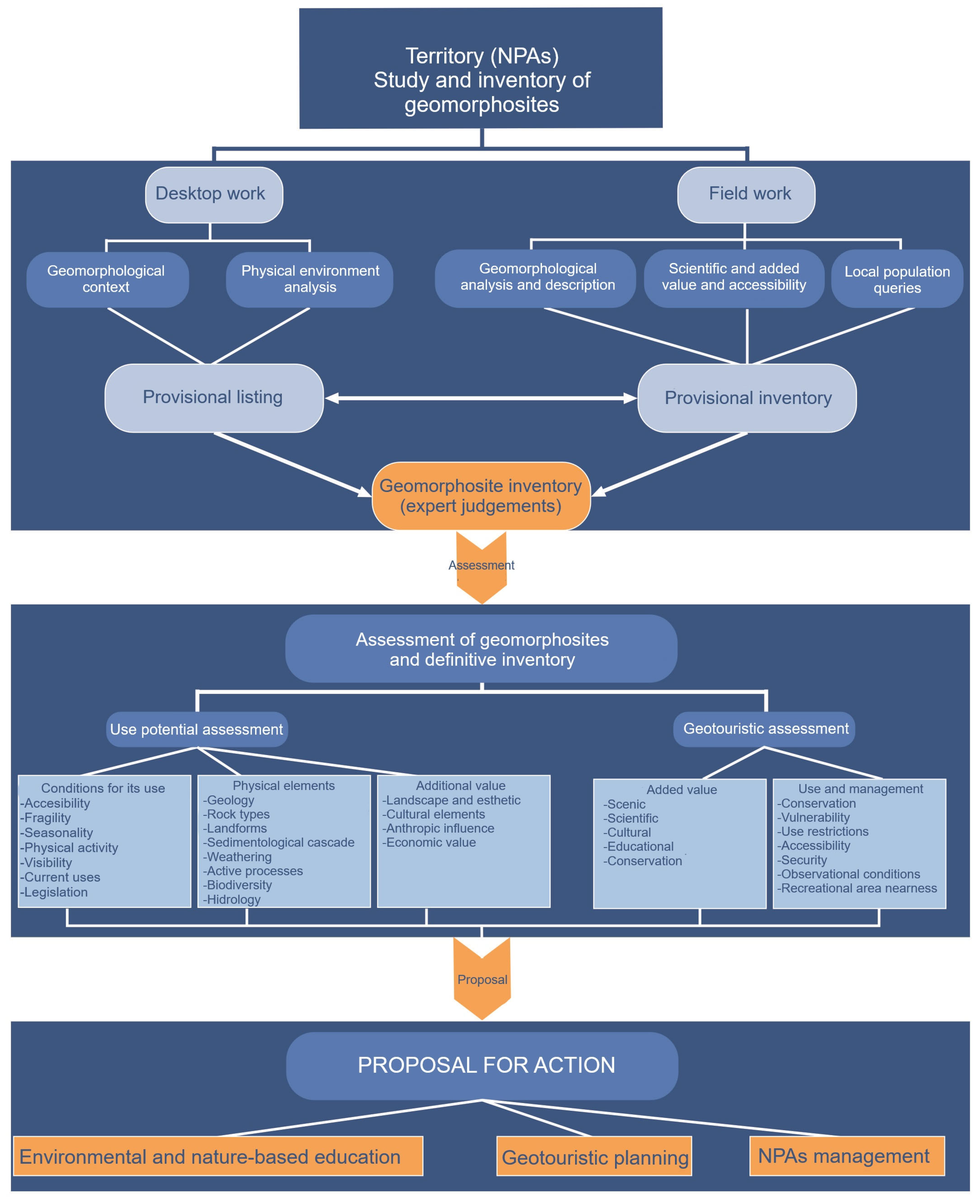
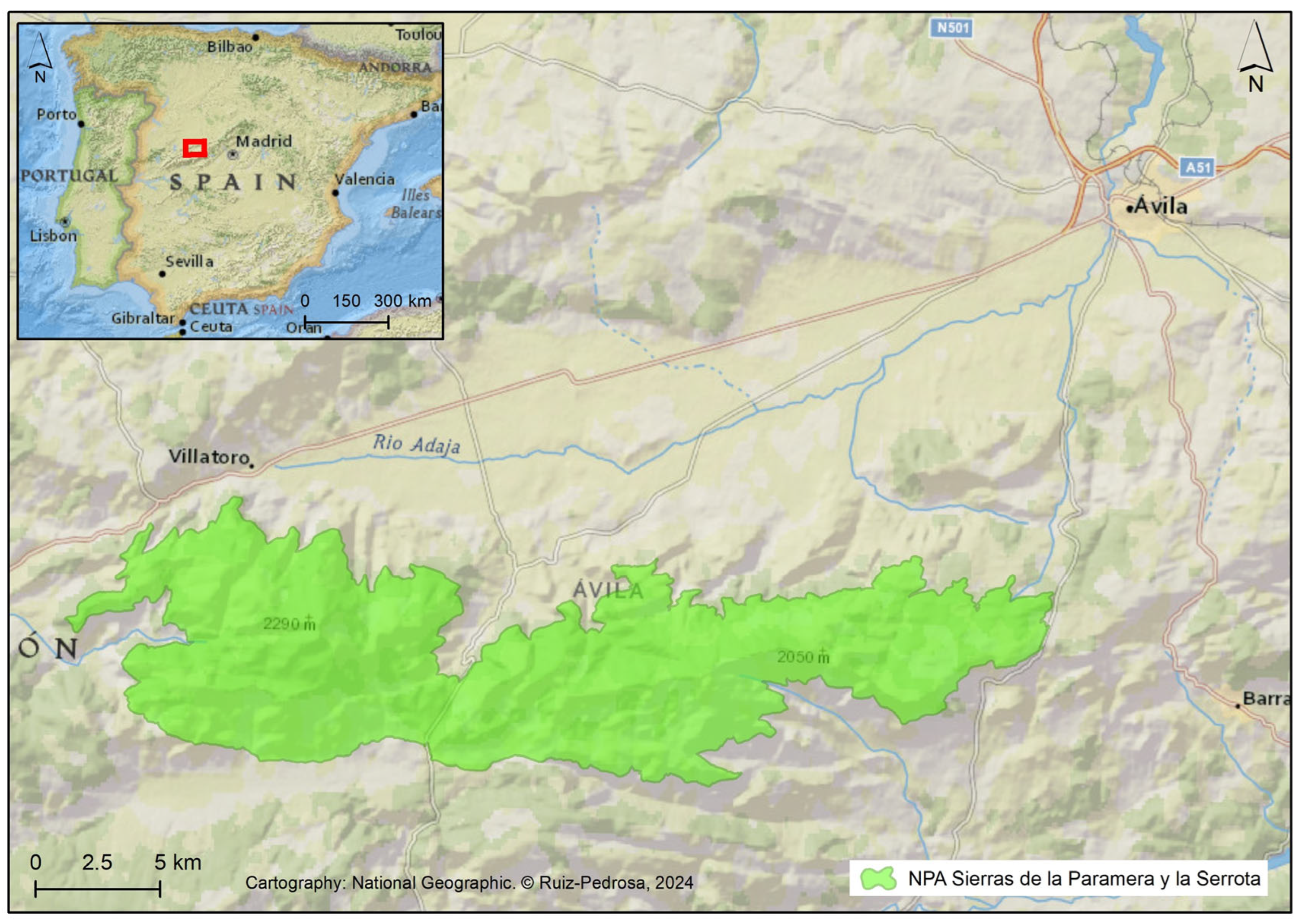
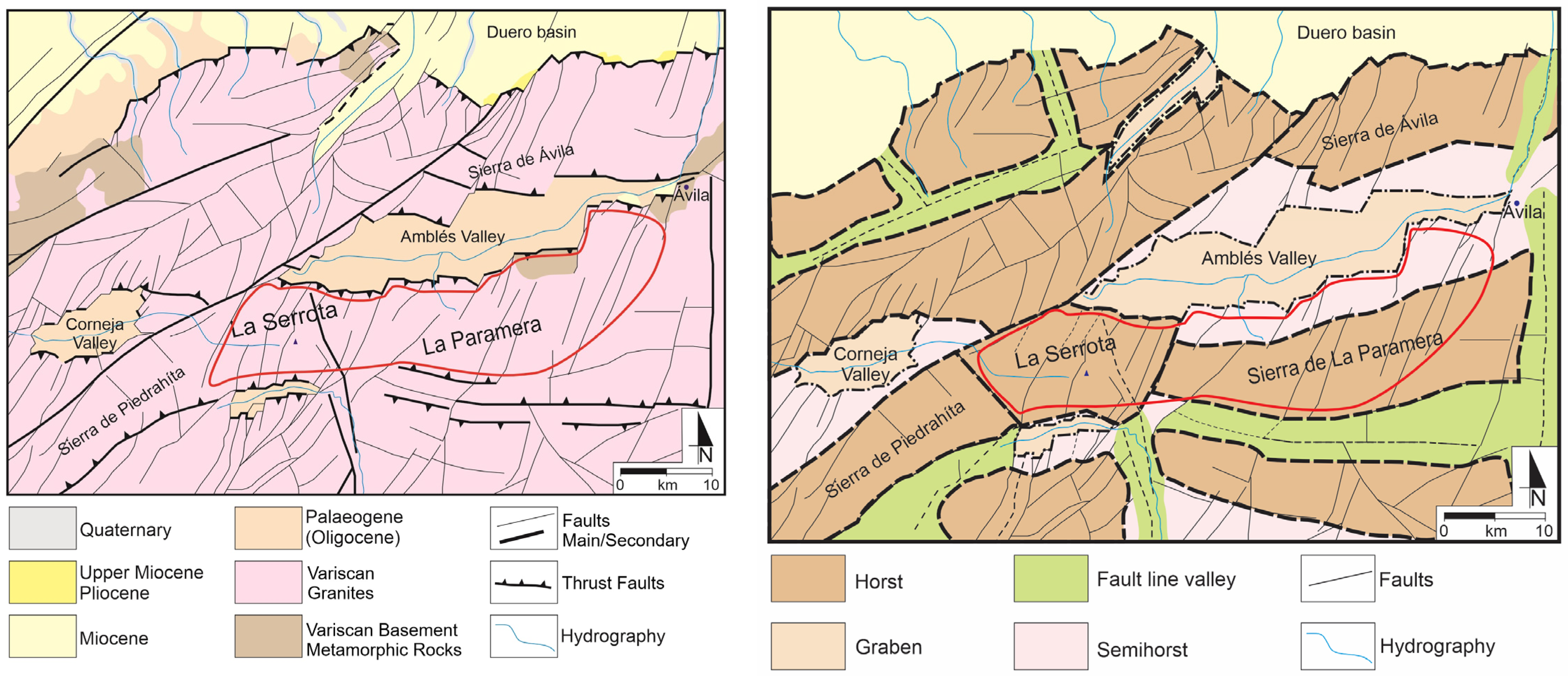
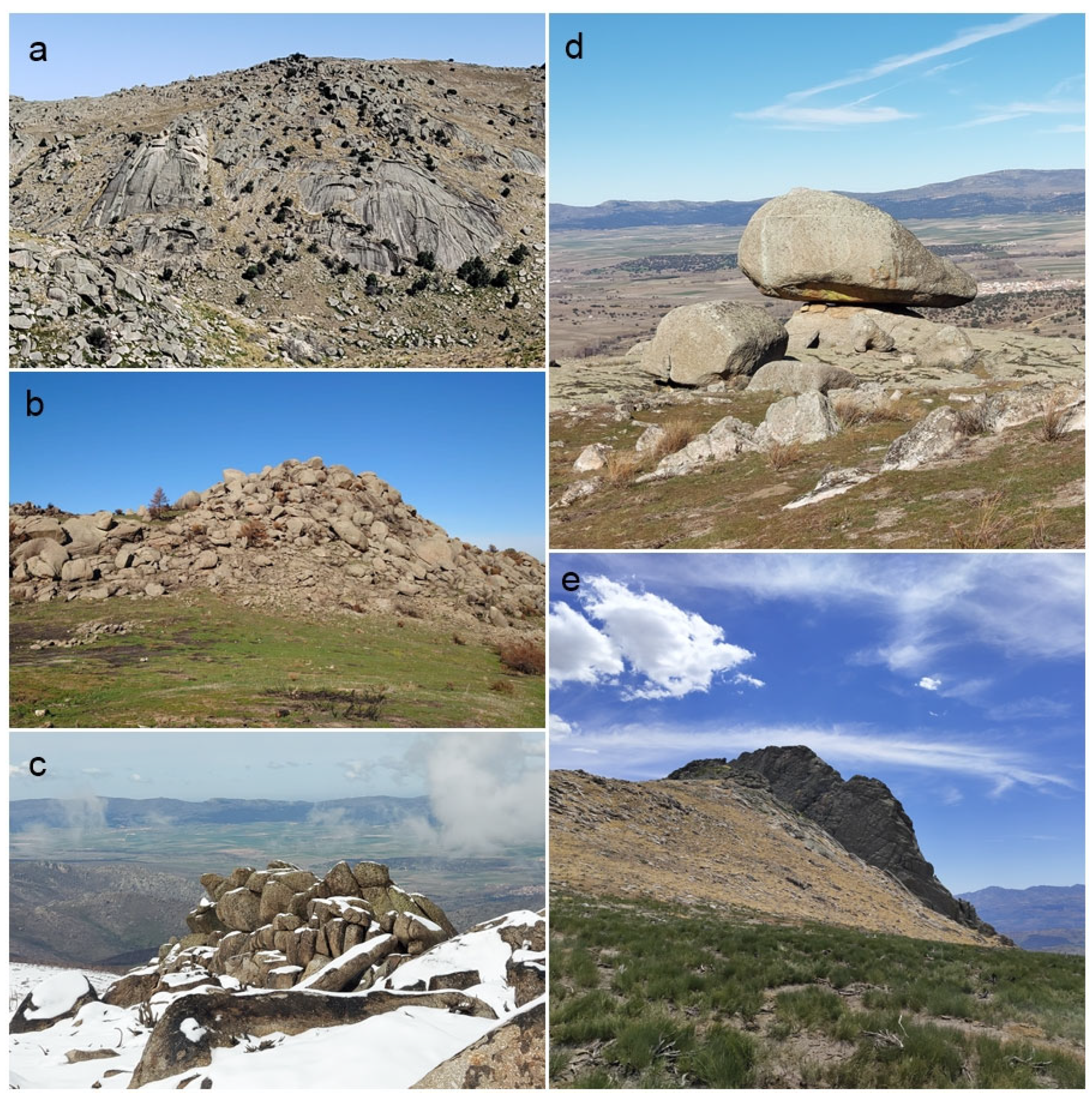

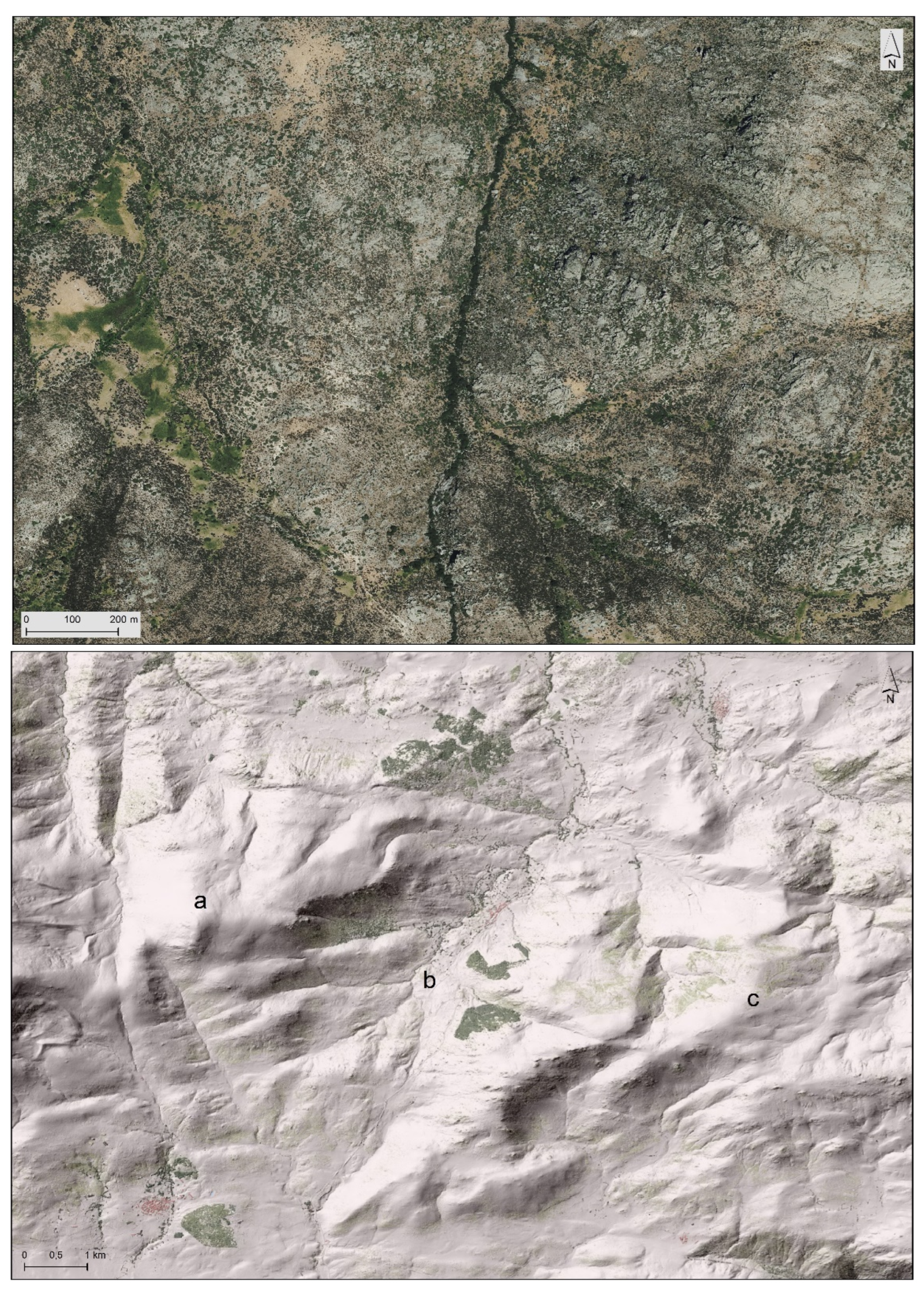
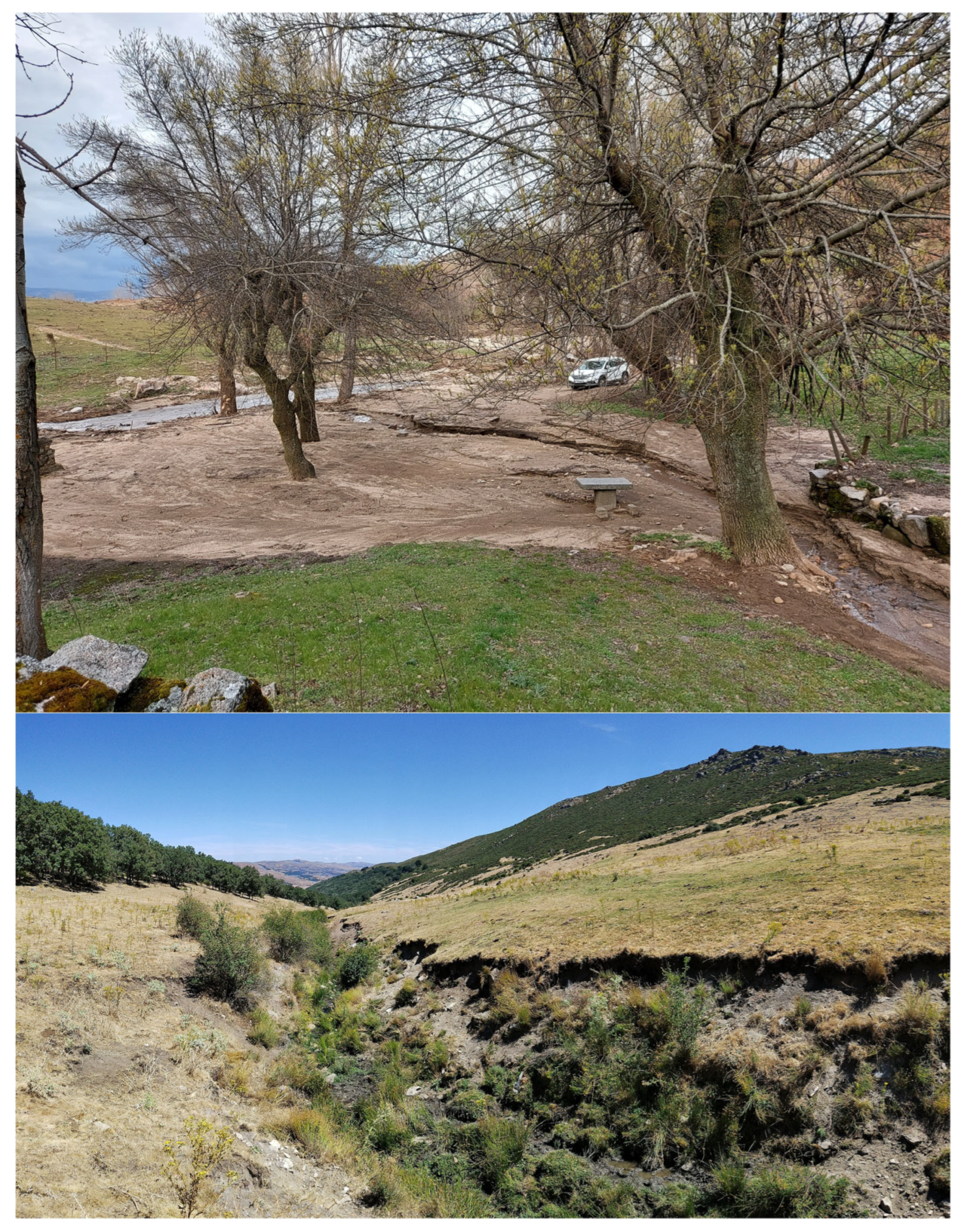

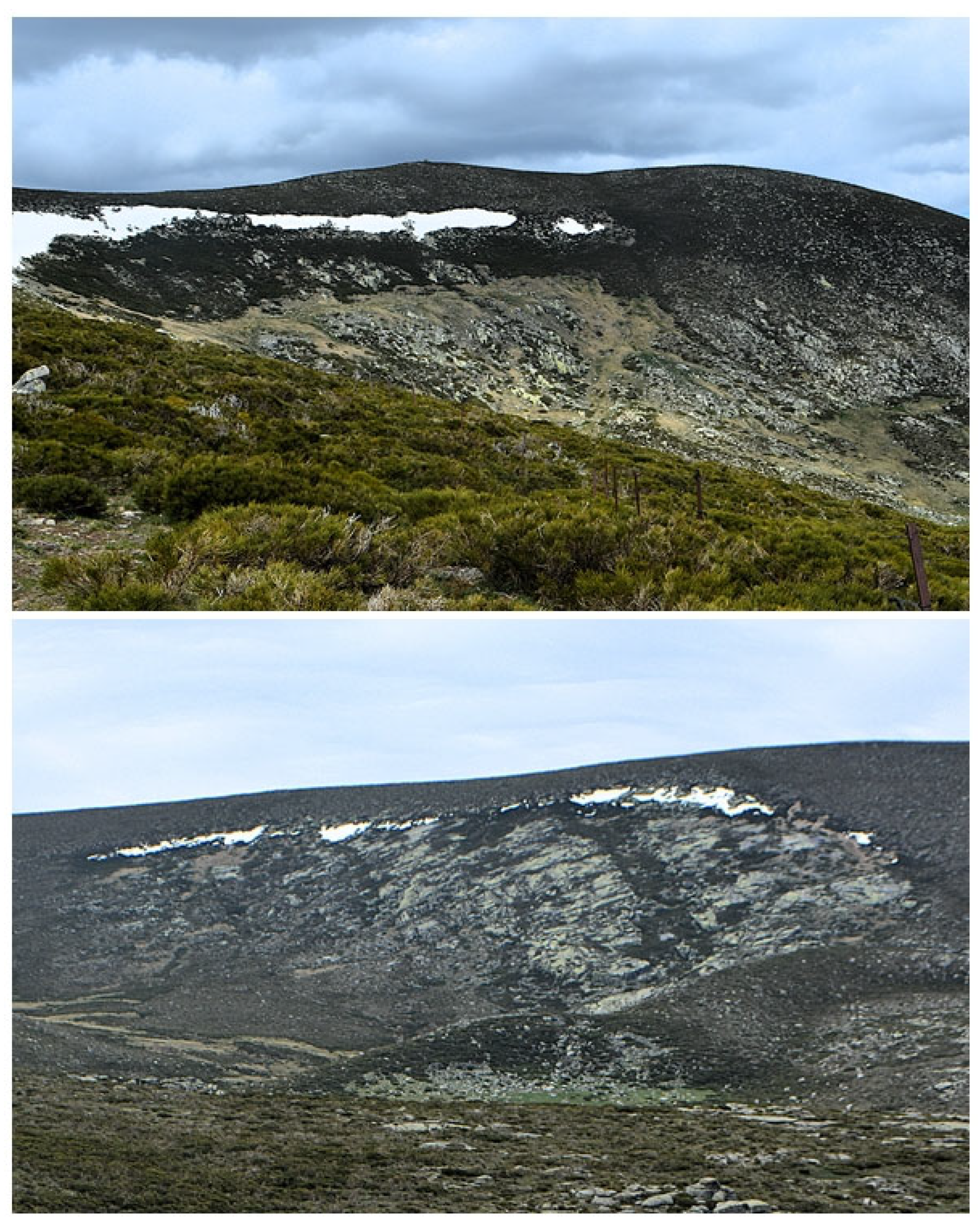
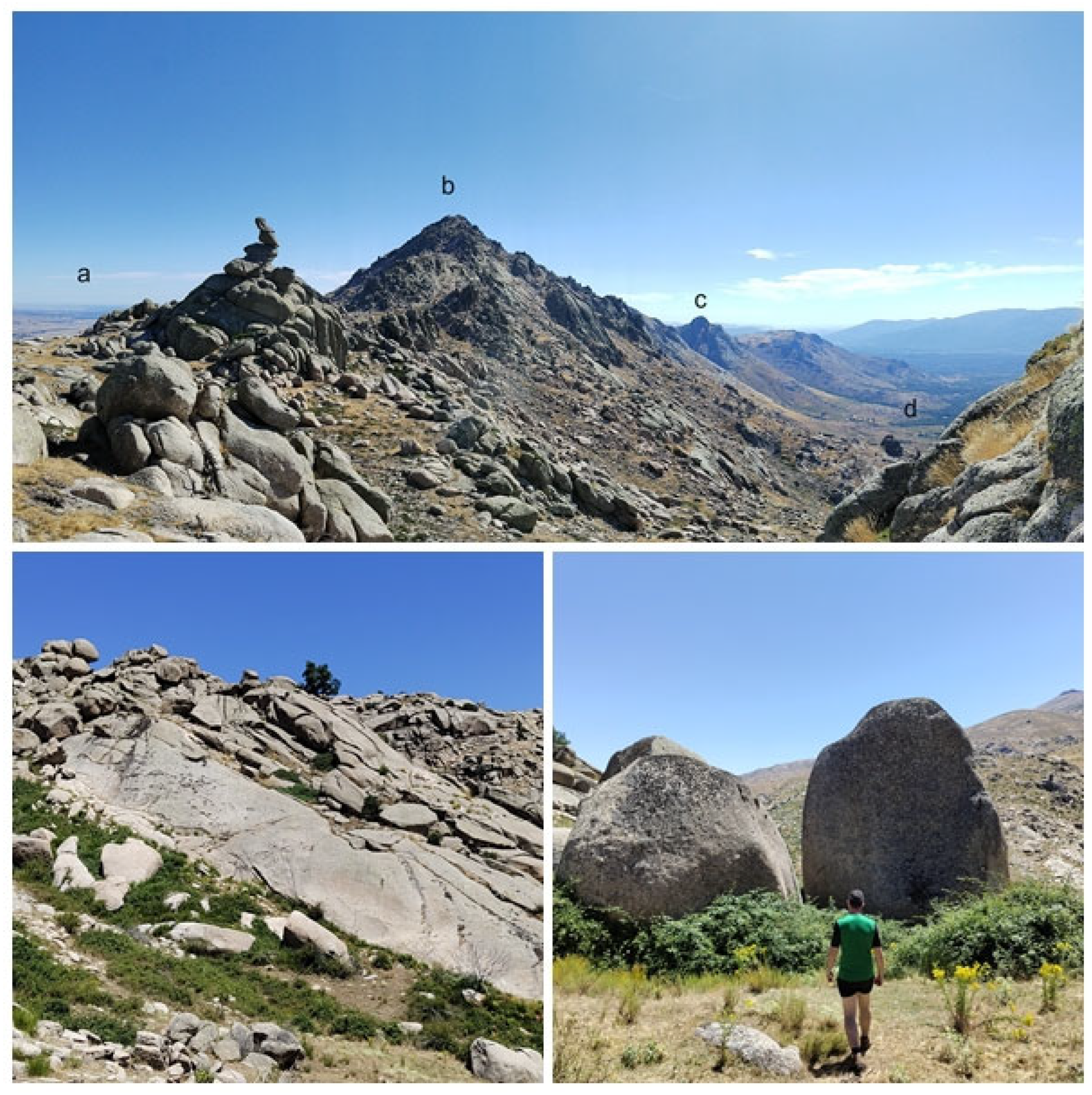
| Accessibility | 0: no path; 2: loose rock path; 4: well-defined path |
| Fragility (risk of degradation) | 0: high (the geomorphosite is already degraded); 2: moderate (the geomorphosite is in the process of degradation); 4: low (no degradation) | |
| Seasonality | 0: can be visited for less than 3 months per year; 2: can be visited for 3–6 months per year; 4: can be visited all year round | |
| Intensity of physical activity (distance and slope) | 0: >15 km and +1.000 m; 2: <10 km and +500 m; 4: <5 km and <500 m | |
| Visibility of the geomorphosite | 0: no visibility; 2: medium visibility; 4: full visibility | |
| Current uses | 0: there are none; 2: occasional use; 4: frequent use | |
| Legislation | 0: there is none; 2: in development; 4: strong protection | |
| TOTAL (up to 28) | ||
| Geology | 0: one geological era; 2: two geological eras; 4: three or more geological eras |
| Rock types (igneous, sedimentary, and metamorphic) | 0: there are none; 2: up to four; 4: five or more | |
| Superficial landforms | 0: there are none; 2: one or two; 4: three or more | |
| Sedimentological cascade | 0: no evidence; 2: one example; 4: two or more examples | |
| Weathering (chemical, physical, or biological) | 0: no evidence; 2: one example; 4: two or more examples | |
| Active processes | 0: no active processes; 2: one example; 4: two or more examples | |
| Biodiversity | 0: no evidence; 2: one example; 4: two or more examples | |
| Hydrology | 0: no liquid or solid water; 2: one example; 4: two or more examples | |
| TOTAL (up to 32) | ||
| Landscape and esthetic | 0: no view of landscape, landscape entirely covered by natural or anthropogenic features; 2: view of landscape obstructed, e.g., by vegetation or other elements of natural environment; 4: wide view of landscape, no obstacles to observation |
| Cultural elements | 0: no existence; 2: one example; 4: more than one example | |
| Anthropic influence | 0: dominance of nature, space little or not at all modified by humans; 2: rural/natural space partially modified by man; 4: anthropogenic influence dominates over natural influence | |
| Economic value | 0: no economic activities; 2: one economic activity; 4: more than two economic activities | |
| TOTAL (up to 16) | ||
| Criteria | Importance | Proposed Numerical Assessment Values | |
|---|---|---|---|
| Scenic: panoramic view, extent of panoramic view, geographic diversity, natural diversity | 15 | 0–5–10–15 | |
| Scientific: integrity, rarity, geodiversity, scientific knowledge | 10 | 0–5–10 | |
| Cultural: presence of cultural value, value of cultural elements, number of elements, historical diversity | 15 | 0–5–10–15 | |
| Educational: representativeness and clarity of forms or processes, pedagogical exemplarity, didactic documentation available, current educational use | 5 | 0–5 | |
| Conservation | Vulnerability: risk of degradation and fragility | 10 | 0–5–10 |
| Limitations on use: legislation for its protection | 5 | 0–5 | |
| Additional values | 10 | 0–5–10 | |
| Accessibility | 10 | 0–5–10 | |
| Security | 15 | 0–5–10–15 | |
| Observation conditions | 5 | 0–5 | |
| Total (up to 100) | |||
| Nº | Geomorphological Attribution | Type * | Accessibility | Interest | |
|---|---|---|---|---|---|
| 1 | Granite | Place | Representative | Medium | High |
| 2 | Granite | Place | Representative | Medium | High |
| 3 | Fluvial | Place | Representative | Medium | High |
| 4 | Granite | Element | Exceptional | Medium | Medium |
| 5 | Granite | Element | Representative | Medium | Medium |
| 6 | Granite | Place | Representative | Medium | High |
| 7 | Glacial | Place | Exceptional | Medium | High |
| 8 | Fluvial | Place | Representative | High | High |
| 9 | Structural | Place | Representative | Medium | Medium |
| 10 | Granite | Place | Representative | Medium | High |
| 11 | Structural | Place | Representative | High | Medium |
| 12 | Fluvial–Granite | Place | Exceptional | Medium | High |
| Nº | A | B | C | GLOBAL |
|---|---|---|---|---|
| 1 | Medium | Medium | High | MEDIUM |
| 2 | High | Medium | High | MEDIUM |
| 3 | Medium | Medium | Medium | MEDIUM |
| 4 | Medium | Medium | Low | MEDIUM |
| 5 | High | Medium | Medium | MEDIUM |
| 6 | Medium | Medium | Medium | MEDIUM |
| 7 | High | Medium | Medium | MEDIUM |
| 8 | High | Medium | Medium | MEDIUM |
| 9 | Medium | Low | Low | MEDIUM |
| 10 | High | Medium | Medium | MEDIUM |
| 11 | High | Low | Medium | MEDIUM |
| 12 | Medium | Medium | Low | MEDIUM |
| Paramera–Serrota Geomorphosites | Results (Up to 100) | |
|---|---|---|
| Ulaca semihorst | 80 | High |
| Manqueospese granite castle | 55 | Low |
| Picuezo river alluvial fan | 55 | Low |
| Granite rock thermal weathering | 45 | Low |
| Responsos isolated granite rock | 45 | Low |
| Picos Zapateros granite mountain ranges | 60 | Low |
| Serrota glacial cirques | 70 | Medium |
| Adaja river spring | 65 | Low |
| Garganta Honda fault line valley | 45 | Low |
| Gavilanes and Chinitas granite system | 70 | Medium |
| Puerto de Mengamuñoz fault | 60 | Low |
| Picuezo river giant’s kettle | 60 | Low |
Disclaimer/Publisher’s Note: The statements, opinions and data contained in all publications are solely those of the individual author(s) and contributor(s) and not of MDPI and/or the editor(s). MDPI and/or the editor(s) disclaim responsibility for any injury to people or property resulting from any ideas, methods, instructions or products referred to in the content. |
© 2025 by the authors. Licensee MDPI, Basel, Switzerland. This article is an open access article distributed under the terms and conditions of the Creative Commons Attribution (CC BY) license (https://creativecommons.org/licenses/by/4.0/).
Share and Cite
Ruiz-Pedrosa, R.M.; Serrano, E. Geotourism and Local Development in Rural Areas: Geomorphosites as Geotouristic Resources in Sierras de la Paramera y Serrota, Spain. Land 2025, 14, 982. https://doi.org/10.3390/land14050982
Ruiz-Pedrosa RM, Serrano E. Geotourism and Local Development in Rural Areas: Geomorphosites as Geotouristic Resources in Sierras de la Paramera y Serrota, Spain. Land. 2025; 14(5):982. https://doi.org/10.3390/land14050982
Chicago/Turabian StyleRuiz-Pedrosa, Rosa María, and Enrique Serrano. 2025. "Geotourism and Local Development in Rural Areas: Geomorphosites as Geotouristic Resources in Sierras de la Paramera y Serrota, Spain" Land 14, no. 5: 982. https://doi.org/10.3390/land14050982
APA StyleRuiz-Pedrosa, R. M., & Serrano, E. (2025). Geotourism and Local Development in Rural Areas: Geomorphosites as Geotouristic Resources in Sierras de la Paramera y Serrota, Spain. Land, 14(5), 982. https://doi.org/10.3390/land14050982







